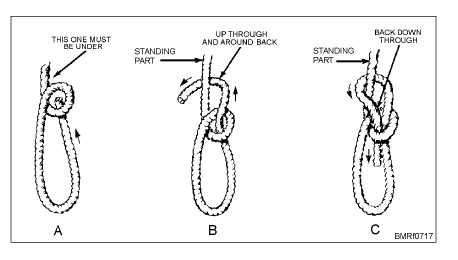Bowline
The bowline, with its many variations, has a lot of
uses. Its chief use is to form an eye; but it can also be
used to secure a line to a pad eye, to secure another ring
around a stanchion or other object, or to bend two lines
together.
To tie a bowline, you should—
1. Grasp the bitter end of the line in the right hand
and the standing part in the left hand (opposite,
if left-handed). Assuming you are using small
stuff, the length of line between your hands
should be about 2 feet.
2. Throw an overhand loop counterclockwise near
your left hand (clockwise near your right hand,
if you are left-handed).
3. Grasp the loop formed and hold it. Pass the bitter
end up through the bottom of the loop, as shown
in figure 7-17, view A.
4. Pull the bitter end up through the loop, and pass
it around behind the standing part of the line (fig.
7-17, view B).
5. Pass the bitter end down through the loop beside
the line that was pulled up through the loop (fig.
7-17, view C).
6. To tighten the knot, grasp the standing part in
one hand and the two lines passed through the
loop with the other hand, and pull.
Becket Bend
The chief value of the becket bend is its use in
binding together two lines of different sizes. If there is a
great difference in sizes or the strain on the line is to be
great, always use a double becket bend.
To fashion a single becket bend, you should—
1. Make a bight in one line and run the bitter end of
the other line up through it, as shown in figure
7-18, view A.
2. Pass the end around behind both parts of the
bight and back under itself (fig. 7-18, view B).
Figure 7-18, view C, shows how you make a double
becket bend by simply taking another turn around the
bight. (These bends are also known as sheet bends.)
Clove Hitch
The clove hitch can be quickly and easily tied in
several ways, and it will hold as long as there is a strain
on it. Once the strain is taken off, however, the hitch
must be checked and tightened to prevent the bitter end
from pulling out when the strain is reapplied. To make
this checking and tightening unnecessary, you lash a
clove hitch with a half hitch around the standing part.
To tie this hitch (fig. 7-19), you should—
1. Take a turn with the bitter end.
2. Pass the end across the standing part.
7-16
Student Notes:
Figure 7-17.—Tying a bowline.


